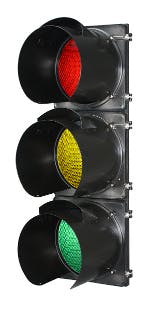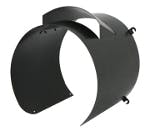With the first major snowy blast of winter gripping much of the mid-west and northeast regions of the United States, major news outlets have been reporting on a potentially deadly flaw of LED-based traffic signals. Because the LEDs used in such signals don’t radiate heat, the bulbs don’t melt snow that can accumulate in the sun visor that surrounds each signal light. Traditional incandescent bulbs would melt such snow. Presumably, a snow-covered red light was a key factor in a fatal auto accident near Chicago last April.
But the snowy LED issue is not a new problem. The Colorado Department of Transportation realized the potential danger five years ago, and sought a solution. Such transportation departments are reluctant to give up the cost savings associated with LED traffic lights, and a simple Snow Scoop from McCain Inc (see below) can inexpensively mitigate the problem.
LEDs offer significant savings to transportation departments. According to this Chicago Tribune column, a 69W incandescent bulb is replaced by an LED version that dissipates only 11W – an 84% savings. Early on, LED signal heads cost two or three times more that the traditional incandescent heads. Today the premium is in the 60 to 80% range. But the LED signal heads last ten times longer so the savings are substantial when you add up energy cost, the cost of the signal heads, and the labor required replacing failed signal heads.
According to this story from the Des Moines Register, the city saves about $100,000 per year on electricity powering 4,000 LED-based signals. Clearly, the city would like to stick with LEDs and preserve that savings. The motivation has been sufficiently strong that transportation workers in Iowa have manually tapped signals to release trapped snow when conditions were problematic.
It turns out that the new visor offers a very economical solution to the problem. The Snow Scoop can be added to most existing traffic signals and cost around $20. The image at left shows the air scoop and the louver slot through whic wind enters the visor, as well as the slot at the bottom where snow exits.







